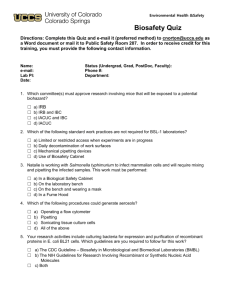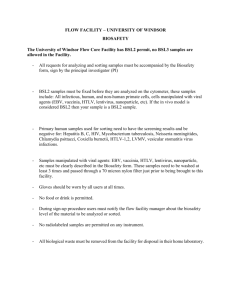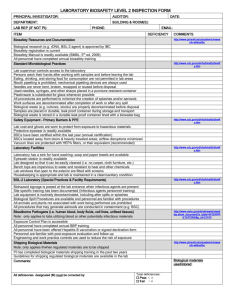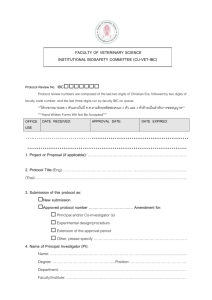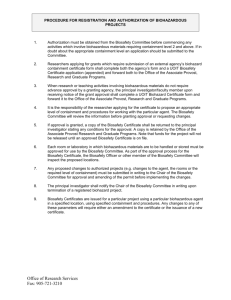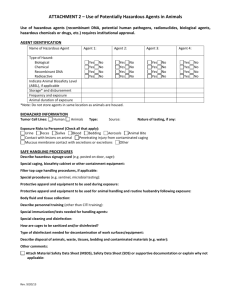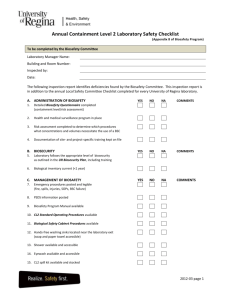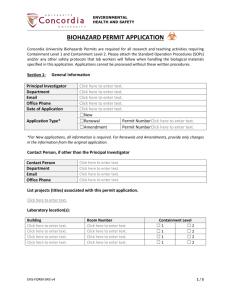Biosafety Quiz
advertisement
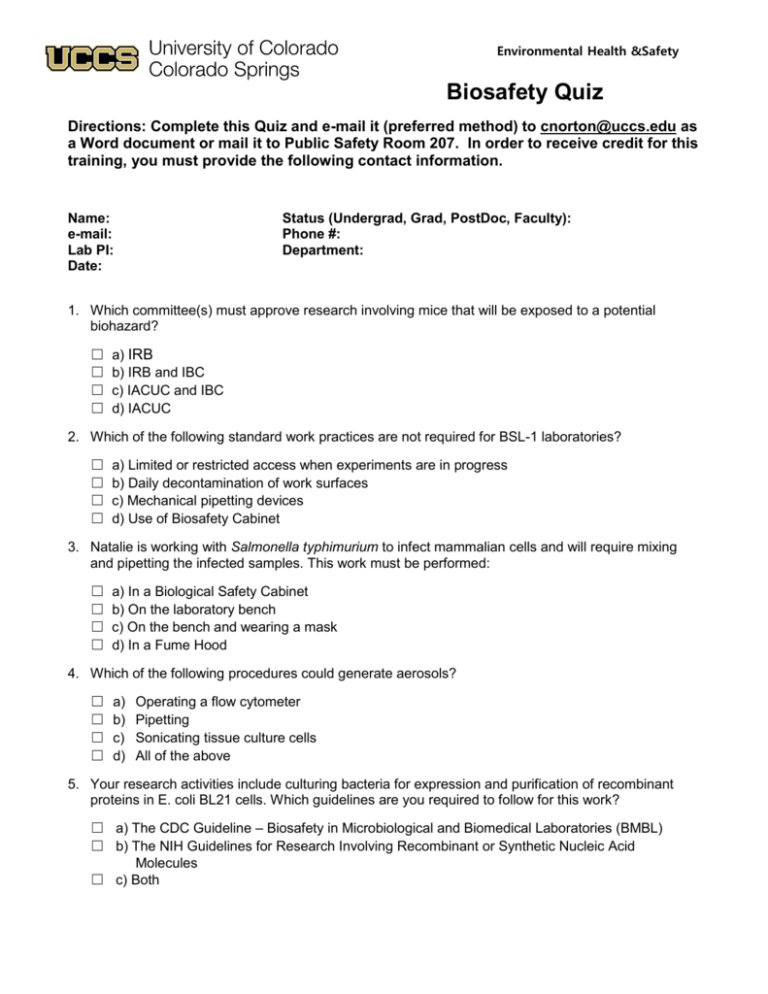
Environmental Health &Safety Biosafety Quiz Directions: Complete this Quiz and e-mail it (preferred method) to cnorton@uccs.edu as a Word document or mail it to Public Safety Room 207. In order to receive credit for this training, you must provide the following contact information. Name: e-mail: Lab PI: Date: Status (Undergrad, Grad, PostDoc, Faculty): Phone #: Department: 1. Which committee(s) must approve research involving mice that will be exposed to a potential biohazard? ☐ ☐ ☐ ☐ a) IRB b) IRB and IBC c) IACUC and IBC d) IACUC 2. Which of the following standard work practices are not required for BSL-1 laboratories? ☐ ☐ ☐ ☐ a) Limited or restricted access when experiments are in progress b) Daily decontamination of work surfaces c) Mechanical pipetting devices d) Use of Biosafety Cabinet 3. Natalie is working with Salmonella typhimurium to infect mammalian cells and will require mixing and pipetting the infected samples. This work must be performed: ☐ ☐ ☐ ☐ a) In a Biological Safety Cabinet b) On the laboratory bench c) On the bench and wearing a mask d) In a Fume Hood 4. Which of the following procedures could generate aerosols? ☐ ☐ ☐ ☐ a) b) c) d) Operating a flow cytometer Pipetting Sonicating tissue culture cells All of the above 5. Your research activities include culturing bacteria for expression and purification of recombinant proteins in E. coli BL21 cells. Which guidelines are you required to follow for this work? ☐ a) The CDC Guideline – Biosafety in Microbiological and Biomedical Laboratories (BMBL) ☐ b) The NIH Guidelines for Research Involving Recombinant or Synthetic Nucleic Acid Molecules ☐ c) Both 6. Once the investigator has decided on the agent, recombinant or synthetic molecule, then he or she must conduct an assessment of risk. This Risk Assessment includes which of the following elements. ☐ a) Identify agent hazards and initial assessment of risk ☐ b) Determine appropriate biosafety level of containment and select additional precautions ☐ c) Identify laboratory procedure hazards ☐ d) All of the above 7. Tran is working with the E. coli strain K12. This agent is not associated with disease in healthy adults. Which Risk Group would this agent be categorized? ☐ a) Exempt from being categorized ☐ b) Risk Group 1 ☐ c) Risk Group 2 ☐ d) None of the above 8. For research that requires Biosafety Level 2 containment, Biological Safety Cabinets must be certified: ☐ ☐ ☐ ☐ a) b) c) d) Daily Monthly Annually Once 9. According to the EHS Biowaste Policy, an autoclave that is used for biohazardous waste must have a spore test (i.e. Bacillus stearothermophilus) performed: ☐ ☐ ☐ ☐ a) b) c) d) Weekly Monthly Every 90 days Every 6 months 10. An appropriate container for autoclave bags containing biohazardous waste: ☐ ☐ ☐ ☐ a) b) c) d) is hard-sided has a foot operated lid is easily decontaminated All of the above 11. Your research only involves the use of non-infectious biological agents so an approved IBC application is not required for this work. ☐True ☐False 12. According to the EHS Biowaste Policy, an autoclave that is used for biohazardous waste must have a maintenance performed by an approved Vendor: ☐ ☐ ☐ ☐ a) b) c) d) Only when it’s not working properly Monthly Every 3 months At least annually 13. Josh is injecting mice with a very low dose of Herpes Simplex Virus–1 (HSV-1) and accidentally sticks his hand that is holding the mouse. Since it was a very low dose of virus and he doesn’t think there is any material left in the syringe that could have been injected in his hand, he decides to remove his gloves and wash his hands thoroughly with soap and water. HSV-1 is a Risk Group 2 agent that requires Biosafety Level 2 containment. What other actions should Josh take? ☐ a) Report this incident to his supervisor ☐ b) Seek medical treatment and report this incident to his supervisor, complete Risk Management form, and notify Biosafety Officer at EHS ☐ c) Report this incident to Risk Management by completing a Needle Stick or Bodily Fluid Exposure Report Form ☐ d) Since this happened during University hours, he went to Arbor Occupational Medicine for medical treatment 14. All lab personnel working in an area where biological agents are used, must be made aware of any potential hazards associated with them? ☐True ☐False 15. Pablo is working with human and animal derived cell lines that have been infected with replication deficient adeno-virus and requires Biosafety Level 2 containment. The minimum PPE required to do this work includes lab coat, safety glasses and disposable gloves: ☐True ☐False 16. The Bench lab has been approved to grow 2 liters of a non-biohazardous bacteria culture, but now needs to increase their production to just over 10 liters in order to cover the number of assays necessary for an upcoming grant application. Is there anything that the Principal Investigator must do? ☐a) ☐b) ☐c) ☐d) No additional approval is necessary by the IBC Notify the Biosafety Officer about the increase in production Notify the Biosafety Officer prior to the increase in production so that any new safety and/or compliance requirements can be met before work begins Submit a new IBC application or an Addendum to the previously approved application 17. The Biohazard Control Plan is contained in all IBC applications and is required to be completed when working with biohazardous or potentially biohazardous agents or materials that require Biosafety Level 2 containment. A Post Exposure Plan may also be required for use of infectious agents. ☐ True ☐ False 18. Who is responsible for performing the Risk Assessment? ☐ ☐ ☐ ☐ a) b) c) d) EH&S The IBC The lab personnel The Principal Investigator 19. A Biohazard Notification sign must be completed and posted on lab entry door(s) in order to meet Biosafety Level 1 or Biosafety Level 2 containment requirements? ☐ True ☐ False 20. Who is responsible for providing training that is specific to the bioresearch being performed? ☐ ☐ ☐ ☐ a) b) c) d) The lab manager or Principal Investigator The lab personnel who is performing the work The Department that you work in EH&S 21. Primary barriers associated with BSL-1 include all except? ☐ ☐ ☐ ☐ a) b) c) d) Lab coats Disposable gloves Biosafety Cabinet Safety Glasses
